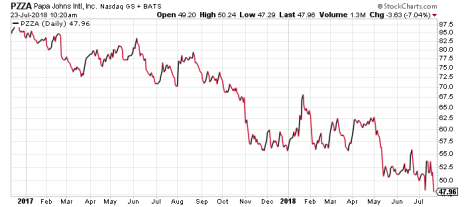December 12, 2016 was the apex for Papa John’s (PZZA). That was the day Papa John’s stock topped 89 for the first time in its history, concluding a furious rally in which shares nearly doubled from 45 earlier in the year.
Profits were bursting—the company grew earnings per share by more than 44% in 2016. And John Schnatter, the company’s founder and namesake, was a bona fide celebrity, appearing in seemingly every commercial for the national pizza joint and being the first person Peyton Manning bro-hugged after winning the Super Bowl earlier that year.
A year and a half later, “Papa John” has become even more well-known—but not for good reasons.
“Papa John” Killing Papa John’s Stock
Schnatter started to come under fire last November, when he blamed his company’s slumping sales on NFL players who decided to kneel for the national anthem (at the time, Papa John’s was one of the NFL’s biggest corporate sponsors). The public outcry grew so loud that Schnatter was forced to resign as CEO in December, though he remained chairman of its board of directors and retained a 29% stake in the company he created.
[text_ad use_post='129629']
Since then, sales and profit growth have completely dried up: in the first full quarter since Schnatter resigned (second-quarter earnings results are due out August 7), revenues declined 5.7%, while EPS tumbled 35%.
Then, earlier this month, came perhaps the most damaging blow of all: Schnatter resigned as chairman of the Papa John’s board after reportedly uttering a racial slur during a May conference call with a marketing agency.
Needless to say, the combination of downward-spiraling sales and humiliating headlines has been bad for Papa John’s stock. How bad? PZZA currently trades at 47, its lowest point since its February 2016 bottom and 46% lower than its December 2016 peak. In fact, Papa John’s stock had already taken such a hit over the last year-plus that Schnatter’s latest scandal barely registered (see chart below).
We write a lot at Cabot about how bad headlines can often be good investment opportunities—a chance to buy low on a good company that Wall Street has over-punished as a result of some unflattering news. Warren Buffett is a big proponent of this “Buy Bad News” strategy too.
But there’s a big difference between bad news that’s fixable or overstated (like Netflix’s (NFLX) lower-than-expected subscriber growth somehow spawning an overnight sell-off in NFLX stock), and a failure that erodes public trust in a company.
Chipotle (CMG) is a good example. Three years ago, the once-revered fast-casual Mexican food chain accidentally poisoned a few dozen customers in 11 states as a result of an E. coli outbreak, and later over 100 more customers in the Boston area due to a norovirus outbreak. Chipotle’s sales instantly went in the tank, and investors began selling out of Chipotle stock in droves: CMG lost nearly half its value in the ensuing year.
Eventually, customers returned to Chipotle. But investors haven’t, at least not to any great extent. CMG stock is down 40% from its 2015 peak despite a big run-up since April.
Don’t Order PZZA
Papa John’s stock seems destined for a similar fate. When the very name of your company becomes synonymous with racist comments, it’s not good for business. To regain customer trust, Papa John’s will likely need to not only overhaul its post-Schnatter image, but may even need to change its name. For years, Schnatter was part of Papa John’s folksy appeal. He’s now the company’s biggest problem.
Until that problem is fixed, I’d steer well clear of Papa John’s stock.
[author_ad]

